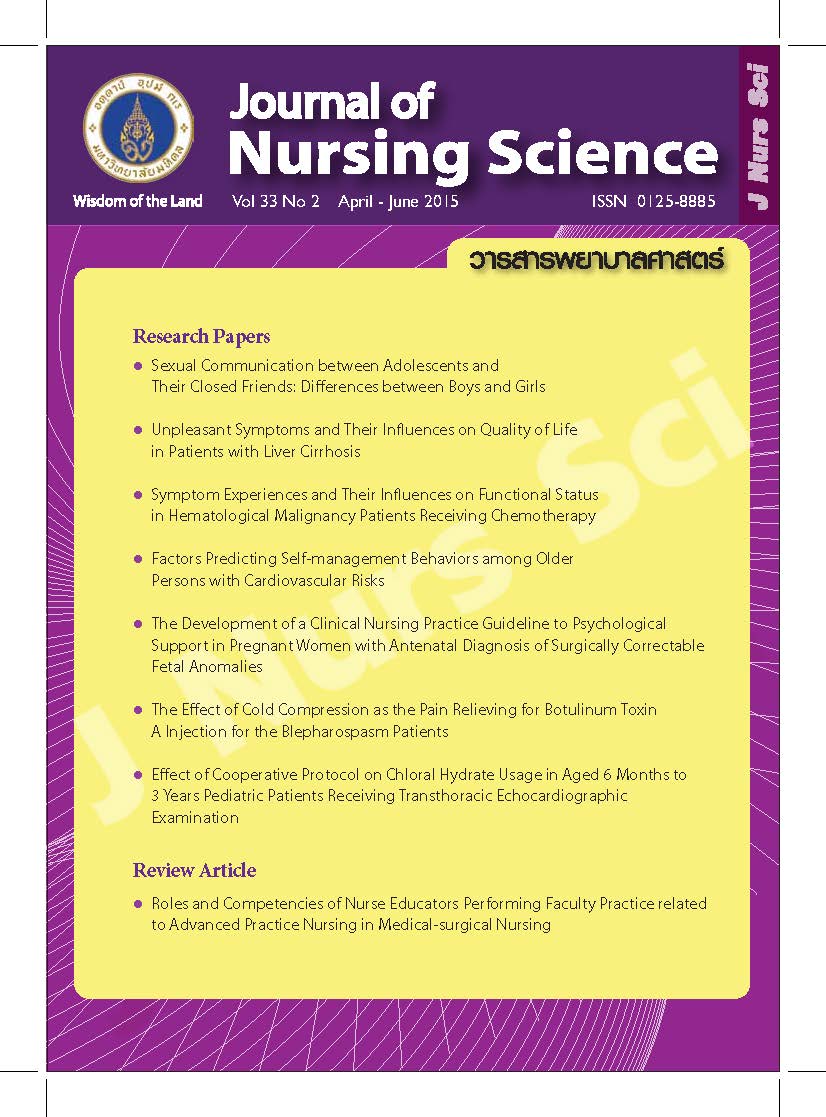Effect of Cooperative Protocol on Chloral Hydrate Usage in Aged 6 Months to 3 Years Pediatric Patients Receiving Transthoracic Echocardiographic Examination
Main Article Content
Abstract
Purpose: To compare chloral hydrate utilization for transthoracic echocardiogram in pediatric patients whom receive cooperative protocol and whom receive routine nursing care.
Designs: Experiment randomized controlled trial.
Methods: We included 133 patients aged between 6 months to 3 years who underwent echocardiogram at Siriraj Hospital. The patients were randomized into 2 groups. The control group (n = 66) received routine nursing care. Displaying dramatic play and distracting pediatric patients appropriated with their ages was used as the cooperative protocol in the intervention group (n = 67). Cardiologists evaluated patients if they needed chloral hydrate sedation to complete examination. The using chloral hydrate sedation, processing times; satisfaction of responsible cardiologists, nurses and the parents were collected. Pearson’s Chi-Square test was used for data analysis.
Main findings: In the interventional group, there were lower using rate of chloral hydrate sedation and shorter overall processing times (both p < .01). The satisfaction scores from cardiologists, nurses and parents in the interventional group were higher compared to the control group (p < .01).
Conclusion and recommendations: The cooperative protocol is useful to reduce chloral hydrate sedation in children. Not only reducing the risk of sedation, but it also provides more time and staff efficiency than standard practice. In addition, the cooperative protocol could provide the necessary echocardiographic information. Reduced risk and more efficient utility will allow the better quality of care especially in hospitals with limited human resources.
ผลของรูปแบบการส่งเสริมความร่วมมือในการตรวจหัวใจด้วยคลื่นเสียงสะท้อนความถี่สูงผ่านผนังทรวงอกในผู้ป่วยเด็กอายุ 6 เดือน - 3 ปี ต่อการใช้ยา Chloral Hydrate
บทคัดย่อ
วัตถุประสงค์: เพื่อเปรียบเทียบอัตราการใช้ยานอนหลับ chloral hydrate ในผู้ป่วยเด็กกลุ่มที่ได้รับรูปแบบการส่งเสริมความร่วมมือในการตรวจหัวใจด้วยคลื่นเสียงสะท้อนความถี่สูงผ่านผนังทรวงอก กับกลุ่มที่ได้รับการดูแลตามมาตรฐาน
รูปแบบการวิจัย: การวิจัยเชิงทดลอง
วิธีดำเนินการวิจัย: กลุ่มตัวอย่างเป็นผู้ป่วยเด็กอายุ 6 เดือน ถึง 3 ปี ที่มารับการตรวจหัวใจด้วยคลื่นเสียงสะท้อนความถี่สูงผ่านผนังทรวงอกที่โรงพยาบาลศิริราช เลือกกลุ่มตัวอย่างตามเกณฑ์ที่กำหนด จำนวน 133 ราย สุ่มเข้าศึกษาแบ่งเป็น 2 กลุ่ม กลุ่มควบคุม จำนวน 66 ราย ได้รับการดูแลตามมาตรฐาน กลุ่มทดลองจำนวน 67 ราย ได้รับรูปแบบการส่งเสริมความร่วมมือในการตรวจหัวใจด้วยคลื่นเสียงสะท้อนความถี่สูงผ่านผนังทรงอกโดยให้ข้อมูลเสมือนการตรวจจริงผ่านกิจกรรมการเล่นและการเบี่ยงเบนความสนใจผู้ป่วยเด็ก แพทย์ผู้ตรวจเป็นผู้ประเมินผู้ป่วยเด็กในการได้รับยา chloral hydrate การวัดผลโดยเปรียบเทียบอัตราผู้ที่ได้รับยานอนหลับ ร่วมกับการประเมินเวลารวมที่ใช้ในการตรวจ ความพึงพอใจของแพทย์ พยาบาล และผู้ปกครอง วิเคราะห์ข้อมูลเปรียบเทียบทางสถิติด้วย Pearson’s Chi-Square test
ผลการวิจัย: พบว่าผู้ป่วยเด็กกลุ่มทดลองมีอัตราการใช้ยานอนหลับ chloral hydrate และมีระยะเวลารวมในการตรวจหัวใจด้วยคลื่นเสียงสะท้อนความถี่สูงผ่านผนังทรวงอกน้อยกว่าอย่างมีนัยสำคัญทางสถิติ (p < .01) คะแนนความพึงพอใจในรูปแบบการส่งเสริมความร่วมมือในการตรวจหัวใจด้วยคลื่นเสียงสะท้อนความถี่สูงผ่านผนังทรวงอกของแพทย์ พยาบาล และผู้ปกครองในกลุ่มทดลองสูงกว่ากลุ่มควบคุมอย่างมีนัยสำคัญทางสถิติ (p < .01)
สรุปและเสนอแนะ: รูปแบบการส่งเสริมความร่วมมือในการตรวจหัวใจด้วยคลื่นเสียงสะท้อนความถี่สูงผ่านผนังทรวงอกไม่เพียงช่วยลดการใช้ยานอนหลับ chloral hydrate แต่ยังช่วยให้บุคลากรมีเวลาและมีประสิทธิภาพการดูแลมากกว่าตามมาตรฐานเดิม นอกจากนี้รูปแบบการส่งเสริมความร่วมมือดังกล่าวยังสามารถให้ข้อมูลการตรวจที่จำเป็น ลดความเสี่ยงจากการใช้ยา และใช้ทรัพยากรอย่างคุ้มค่ามากขึ้น ส่งผลให้คุณภาพการดูแลดีขึ้น โดยเฉพาะอย่างยิ่งในโรงพยาบาลที่มีทรัพยากรบุคคลจำกัด
คำสำคัญ: รูปแบบการส่งเสริมความร่วมมือ การตรวจหัวใจเด็กด้วยคลื่นเสียงสะท้อนความถี่สูงผ่านผนังทรวงอก ผู้ป่วยเด็ก ยา Chloral Hydrate
Article Details
Copyright Notice: Nursing Science Journal of Thailand has exclusive rights to publish and distribute the manuscript and all contents therein. Without the journal’s permission, the dissemination of the manuscript in another journal or online, and the reproduction of the manuscript for non-educational purpose are prohibited.

Disclaimer: The opinion expressed and figures provided in this journal, NSJT, are the sole responsibility of the authors. The editorial board bears no responsibility in this regard.

